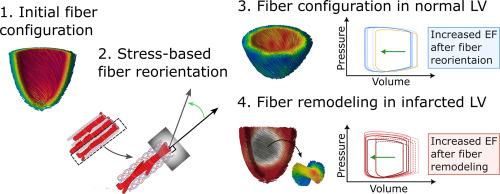Multiscale fiber remodeling in the infarcted left ventricle using a stress-based reorientation law
IF 9.4
1区 医学
Q1 ENGINEERING, BIOMEDICAL
引用次数: 0
Abstract
The organization of myofibers and extra cellular matrix within the myocardium plays a significant role in defining cardiac function. When pathological events occur, such as myocardial infarction (MI), this organization can become disrupted, leading to degraded pumping performance. The current study proposes a multiscale finite element (FE) framework to determine realistic fiber distributions in the left ventricle (LV). This is achieved by implementing a stress-based fiber reorientation law, which seeks to align the fibers with local traction vectors, such that contractile force and load bearing capabilities are maximized. By utilizing the total stress (passive and active), both myofibers and collagen fibers are reoriented. Simulations are conducted to predict the baseline fiber configuration in a normal LV as well as the adverse fiber reorientation that occurs due to different size MIs. The baseline model successfully captures the transmural variation of helical fiber angles within the LV wall, as well as the transverse fiber angle variation from base to apex. In the models of MI, the patterns of fiber reorientation in the infarct, border zone, and remote regions closely align with previous experimental findings, with a significant increase in fibers oriented in a left-handed helical configuration and increased dispersion in the infarct region. Furthermore, the severity of fiber reorientation and impairment of pumping performance both showed a correlation with the size of the infarct. The proposed multiscale modeling framework allows for the effective prediction of adverse remodeling and offers the potential for assessing the effectiveness of therapeutic interventions in the future.
Statement of Significance
The organization of muscle and collagen fibers within the heart plays a significant role in defining cardiac function. This organization can become disrupted after a heart attack, leading to degraded pumping performance. In the current study, we implemented a stress-based fiber reorientation law into a computer model of the heart, which seeks to realign the fibers such that contractile force and load bearing capabilities are maximized. The primary goal was to evaluate the effects of different sized heart attacks. We observed substantial fiber remodeling in the heart, which matched experimental observations. The proposed computational framework allows for the effective prediction of adverse remodeling and offers the potential for assessing the effectiveness of therapeutic interventions in the future.

利用基于应力的重定向法则重塑梗死左心室的多尺度纤维
心肌内肌纤维和细胞外基质的组织结构在决定心脏功能方面起着重要作用。当发生心肌梗塞(MI)等病理事件时,这种组织结构会被破坏,导致泵血性能下降。目前的研究提出了一种多尺度有限元(FE)框架,以确定左心室(LV)中真实的纤维分布。这是通过实施基于应力的纤维重新定向法则来实现的,该法则旨在使纤维与局部牵引矢量对齐,从而使收缩力和承载能力最大化。通过利用总应力(被动和主动),肌纤维和胶原纤维都会重新定向。模拟预测了正常左心室的基线纤维配置,以及不同大小的心肌梗死导致的不利纤维重新定向。基线模型成功捕捉了左心室壁内螺旋纤维角度的横向变化,以及从基底到心尖的横向纤维角度变化。在心肌梗死模型中,梗死区、边界区和远端区域的纤维重新定向模式与之前的实验结果非常吻合,左手螺旋构型的纤维明显增加,梗死区的纤维分散度增加。此外,纤维重新定向和泵送性能受损的严重程度都与梗塞的大小相关。所提出的多尺度建模框架可有效预测不良重塑,并为评估未来治疗干预的有效性提供了可能。意义说明:心脏内肌肉和胶原纤维的组织结构在确定心脏功能方面起着重要作用。心脏病发作后,这种组织会被破坏,导致泵血性能下降。在当前的研究中,我们在心脏计算机模型中实施了基于应力的纤维重新定向法,旨在重新排列纤维,从而最大限度地提高收缩力和承载能力。主要目的是评估不同大小的心脏病发作的影响。我们观察到心脏纤维发生了实质性重塑,这与实验观察结果相符。所提出的计算框架可以有效预测不良重塑,并为评估未来治疗干预的有效性提供了可能。
本文章由计算机程序翻译,如有差异,请以英文原文为准。
求助全文
约1分钟内获得全文
求助全文
来源期刊

Acta Biomaterialia
工程技术-材料科学:生物材料
CiteScore
16.80
自引率
3.10%
发文量
776
审稿时长
30 days
期刊介绍:
Acta Biomaterialia is a monthly peer-reviewed scientific journal published by Elsevier. The journal was established in January 2005. The editor-in-chief is W.R. Wagner (University of Pittsburgh). The journal covers research in biomaterials science, including the interrelationship of biomaterial structure and function from macroscale to nanoscale. Topical coverage includes biomedical and biocompatible materials.
 求助内容:
求助内容: 应助结果提醒方式:
应助结果提醒方式:


